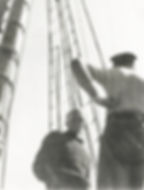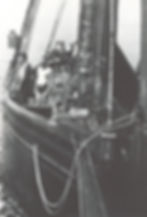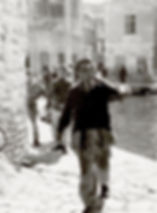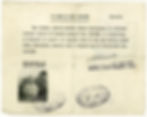
ABOUT ANDERS LASSEN

Name:
Anders Frederik Emil Victor Schau Lassen
Family:
Father: Landowner Emil Victor Schau Lassen
Mother: Suzanne Maria Signe, born Raben-Levetzau
Siblings: Frants Axel Lassen, 1922 and Bente Lassen, 1931
Anders Lassen’s family were very patriotic. The patriotism was mainly due to the death of
seven brothers during the wars in 1848 and 1864.




THE CHILDHOOD
Anders Frederik Emil Victor Schau Lassen was born on September 22nd, 1920, at Hoevdinggaard’s mansion located at South Zealand. His father was landowner Emil Victor Schau Lassen and his mother, Suzanne Maria Signe Raben-Levetzau. Later on, his parents had two more children; Frantz Axel Lassen in 1922 and Bente Lassen in 1931.
It was a family with great patriotism as Anders Lassen’s great-grandfather on his father’s side, and his brother died in the battle at Dybboel in 1864. And two of the great-grandfather’s other brothers died in the three-year war in 1848-1850. In fact, all the brothers related to the great-grandfather died during this period; either in war or because of typhoid.
Anders and Frantz had an amazing childhood, where they enjoyed the opportunity to go fishing and spend time in the nature. When the family moved to Baekke, Anders got an air rifle, which he began to use right away, chasing rats and minor birds.
Anders Lassen started at Herlufsholm boarding school in 1931. However, the teachers saw him as way too “careless and carefree” and he did not perform well. Still, everyone at the school liked and respected him. Anders got a serious kidney inflammation, which meant that he fell behind in school, and the family decided that he should move to another school in Lundby instead.
Anders Lassen just managed to pass his exam, though he had the poorest lower secondary education grades of all the graduates. However, during his time in school, Anders Lassen discovered some completely different skills, which meant that other kids in the area favoured him. A family visit awakened Anders’ interest im archery. Gregers Ahlefeldt-Laurvig- Bille stopped by and showed the family some homemade bows and arrows. He taught Frantz and Anders Lassen to make their own bows and arrows, and encouraged them to further develop their hunting skills. Anders Lassen had a unique talent for archery, among other things he was very good at hitting birds in the air. Furthermore, he developed a special technique, where he sneaked up on a deer, began to run without any noise and got close to the deer, before he shot the deer while running. He used this technique one time during a training exercise in Scotland, where he ran close to a deer and killed it with a knife. His fellow soldiers were very happy, as they now had food for the next couple of days.
Frantz and Anders were outdoor people. Mostly they did not come home at night, but neither their mother nor father was ever worried, as they could always see the smoke from the boys’ bonfire, and therefore knew that they were all right.




THE SAILOR
At the age of 18 and after his lower secondary school examination, Anders Lassen went to Ollerup Gymnastics School for a few months, before he decided to enter the merchant fleet. He left Copenhagen onboard M/S Fionia from the Danish shipping company called OEK on January 19th 1939. During this trip, Anders Lassen described his life at sea as a boy, who is a bit bored. However, he found his visits to other harbors exiting, and he experienced both the most beautiful and the less attractive places.
On March 20th, 1939, M/S Fionia headed home to Copenhagen and the entire family was there to receive him at the dock May 11th, 1939. On June 21st 1939 Anders Lassen was hired at M/T Eleonora Maersk as an aspirant with another Danish shipping company called A.P. Moeller. He was now a sailor, which suited him better than the previous trip. When he left Denmark, nobody knew that it would be the last time he was in the country.
The last physical contact the family had with Anders was in Hamburg in August 1939. Suzanne Lassen visited him for four days and leaving on August 11th 1939. After the war broke out on September 1st 1939, Anders wrote home, that he got a triple hire, which he was excited about, in fact he was a bit worried about sailing to the United States, as there is no risk coverage.
On April 9 th, 1940 the war seriously started to worry Anders Lassen. Before this, he did not show much interest in the war, but when Denmark got occupied, it made Anders Lassen very angry, and he saw it as his duty to fight against the Germans.
On April 9 th, 1940, a sailor on Elenoara Maersk received a message saying, that the ship needed to sail to the nearest natural, German or Italian harbour. However, the crew decided not to do so, as the American shipyard told the ship to stay in international waters. Therefore, they took a chance and forced the captain to sail into an allied harbor. However, this did not happen before the crew, including Anders Lassen, signed a paper saying that the crew had been disobedient to the captain. The crew gave a statement in writing, that they worked under English rules. Anders Lassen and the telegraphist unsuccessfully tried to enter the Royal Air Force, as they didn’t accept foreigners this early in the war.
However, Anders Lassen demonstrated how good he was as a shooter, thereby becoming the most important man on the ship when fighting against mines and submarines, which Eleonara Maersk was subject to. Even so, Anders Lassen really wanted to fight against the Germans. He tried to get transferred from Eleonara Maersk, which didn’t happen until November in 1940, where he got hired onboard an English ship, which brought him to Scapa Flow in the Orkney Islands.




THE SOLDIER
On Christmas day in 1940, Anders Lassen said goodbye and travelled to Newcastle. Once again, he considered applying to the Royal Air Force, but a meeting with a Danish captain, Werner Iversen, was the reason why Anders Lassen on January 24, 1940, asked to fight in the battle against Denmark’s enemies, who were at war with Germany, on January 24 th 1940.
A couple of weeks later the military training began, but Anders thought it was boring and useless. One could have wished, that Anders Lassen would have been sent to Denmark as an agent for the Special Operation Executive (SOE), but his temper and personality obstructed his prospects to work as an agent – the Germans would expose him.
Additionally, Anders Lassen missed the ocean, which would become the reason for his transfer from SOE. Anders had a meeting with Captain Gustavus March-Phillips, called GUS and his second in command Geoffrey Appleyard, called Apple. These two men were about to start up a small special service, and they were looking for a young man with knowledge about the ocean. In this context, Anders Lassen’s name came up. In April 1941, he arrived at Poole in Southern England, where he was a part of the crew on the wooden ship “Maid Honor”, which should be used in a special task. However, before they could start, they had to make many exercises onboard, where Anders Lassen could use his previously learned skills. The rest of the team considered him very praiseworthy.
During Operation Postmaster in January 1942, where Duchessa d’Aosta at Fernando Po was hijacked, Anders Lassen showed resourcefulness. And before they got back to the harbor, GUS had made him a Second Lieutenant, which was a significant achievement that early in the war. The Ministry of War later on confirmed the nomination.
Anders Lassen went to Africa to educate soldiers, and after a while, he went back to England and got accepted to the Small Scale Raiding Force. The Unit, who had GUS as a boss, was assigned to make pinpricks operations against the German forces on the English islands and Northern French coasts. In 1942, Anders Lassen participates in many of these operations, and every time he demonstrated great courage. He had an uncompromising attitude and hates the Germans with all of his heart, which he mentions in his journals several times.
However, during an operation where Anders Lassen was not present because of an injury, Gus March-Phillips dies, and Anders noted the following in his journal; “The only man I really liked and respected”. Anders Lassen was named Lieutenant in November 1942 and in December that same year, he received his Military Cross because of his efforts in
Operation Postmaster as well as Barricade and Basalt.
In the beginning of 1943, Anders Lassen was transferred to the Special Air Service (SAS) under commando officer David Stirling. However, David Stirling got captured in Libya, nobody knew the future of SAS. Eventually, other people took control and the Special Boat Service was created with 230 men, and Lord Jellicoe appointed commander of the service.
Lord Jellicoe and Anders Lassen became good friends and Anders kept outdoing himself during operations in the Greek archipelago. Once again, the intention was to make small operations, to maintain forces in the area and, by doing so exhausting the enemy’s fighting forces on other fronts.
In the summer 1943, Anders Lassen participated in the Operation Albumen at Crete. The
purpose of this operation was to attack three German airfields and create as much damage as possible. Anders Lassen’s task was to attack the airfield at Kastelli. On his team, he had three companions, and they managed to make a huge attack to make the Germans think, that they were more than just four men. The four men destroyed eight aircrafts, of which four of them were Ju-87 Stukas. Furthermore, they ignited large fuel bearings on the airfield.
Until mid-1944, Anders Lassen participated in more operations against Italian and German bastions located on Greek islands. Each of the operations lasted several weeks, before the soldiers return to their base in Lebanon to recover. Because Anders Lassen understood the local peoples' worries on the islands concerning all the damage during their operations, he obtained great respect as a leader.
In August 1944, SBS and Anders Lassen arrived in Athens, and later the same year, Anders Lassen and his 40-50 men got the Germans to withdraw from Saloniki. Anders delivered the great news to the English main force, that Saloniki was now liberated, and that his team were ready for replacement. The operation took almost 14 days and Anders Lassen and his crew managed to keep the 150,000 citizen calm.
From December 1944 until February 1945, Anders Lassen served as a governor at Crete. He should secure peace between the German forces and the freedom fighters on the Island, who had a non-attack agreement. By having this agreement, the Germans could survive on the Island. In a meeting between Anders Lassen and the German commander, the German commander told him that he was willing to surrender to Anders Lassen, but he was afraid that the British force was not big enough to secure the safety of the Germans.
Anders Lassen achieved great status on the Island after the attack on the air force in Kastelli, and the various freedom fighters supported him. However, one time freedom fighters attacked Heraklion and the English soldiers died or were badly injured.
Shortly after their funeral, Anders Lassen travelled to Italy by ship to participate in the battles of this region.
THE DEATH IN COMMACHIO
In Italy, SBS and Anders Lassen were stationed in the coast area at Commachio. SBS should investigate if it was possible to enter through the massive German front, which had put an end to the advancement. It was clear that the soldiers fortified the area and it was difficult to get information about the German defence. The allied would use SBS for a diversion manoeuvre, and Anders Lassen got assigned with the task to enter the fortified area on April 8th during the night.
The mission did not go as planned. It failed and during April 8th and April 9th 1945 Anders Lassen lost his life in a battle, where he saved his team from complete extinction by sacrificing his own life.
For this bravery, Anders Lassen was assigned the Victoria Cross. Below you can find the motivation for awarding the Victoria Cross, when it was announced on September 7th 1945, in the London Gazette.